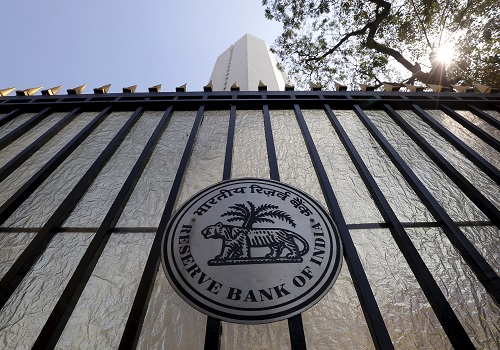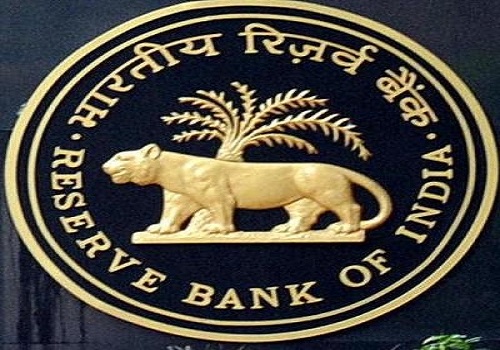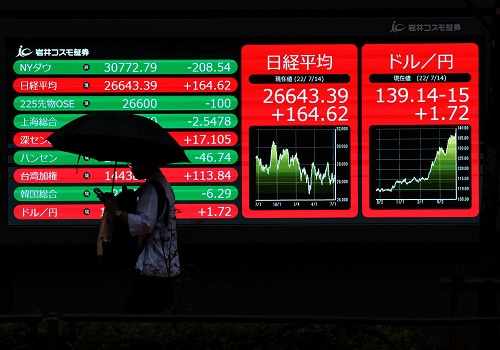Crudeoil trading range for the day is 6328-6624 - Kedia Advisory

Follow us Now on Telegram ! Get daily 10 - 12 important updates on Business, Finance and Investment. Join our Telegram Channel
Gold
Gold prices settled down by 0.53% at 71,834, influenced by a U.S. inflation report that matched estimates. Despite this dip, the precious metal achieved a fourth consecutive monthly gain, buoyed by expectations that the Federal Reserve may announce rate cuts later this year. Speculation about potential rate cuts by the ECB, the Bank of Canada, and notable moves by the Reserve Bank of India, which transferred over 100 tonnes of gold to domestic vaults for the first time since 1991, further influenced the market. The RBI's total gold holdings at the end of March stood at 822.1 tonnes, with 413.8 tonnes held overseas. In the retail sector, high prices dampened demand for physical gold across most Asian markets, compelling Indian dealers to offer discounts for the fourth straight week. Discounts in India reached up to $9 an ounce over official domestic prices, slightly lower than the previous week's $13. In contrast, premiums in China, the world's largest gold consumer, ranged from $24-$33 per ounce, up from $15-$20 the previous week. However, gold imports to China via Hong Kong fell by 38% in April compared to March, highlighting a shift from the high consumption levels seen in the first quarter of the year. Technically, the gold market is experiencing fresh selling pressure, with open interest increasing by 0.5% to 17,050 as prices dropped by 382 rupees. Current support for gold is at 71,530, with a potential test of 71,230 levels if this support is breached. On the upside, resistance is anticipated at 72,400, and a move above this level could see prices testing 72,970.
Trading Ideas:
* Gold trading range for the day is 71230-72970.
* Gold settled lower after a reading of U.S. inflation came in line with estimates.
* The odds for a Fed's ease increased slightly for September, November and December.
* UBS says recently raised our year-end price forecast for gold to $2,600/oz.
Silver
Silver prices fell by 2.71% to 91,570 as investors booked profits following U.S. inflation data that met expectations, increasing the likelihood of the Federal Reserve lowering interest rates this year. The Personal Consumption Expenditures (PCE) Price Index rose 0.3% in April, aligning with forecasts, and annual PCE inflation stood at 2.7%. This data bolstered traders' bets on a potential rate cut by the Fed in September. However, key Fed officials, including Dallas Fed President Lorie Logan and Atlanta Fed President Raphael Bostic, expressed caution about imminent rate cuts, citing ongoing concerns about inflation and a strong labor market. India's silver imports surged dramatically in the first four months of the year, surpassing the total imports for all of 2023. This spike was driven by increasing demand from the solar panel industry and investor expectations of silver outperforming gold. India imported a record 4,172 metric tons of silver from January to April, up from 455 tons during the same period last year, with nearly half of these imports coming from the UAE due to lower import duties. Technically, the silver market is experiencing long liquidation, evidenced by a 7.64% drop in open interest to 24,810 while prices fell by 2,553 rupees. Silver currently finds support at 90,230, with the potential to test 88,895 levels. Resistance is likely at 94,025, and a move above this could see prices testing 96,485. The significant drop in open interest suggests that traders are closing out long positions, contributing to the recent price decline.
Trading Ideas:
* Silver trading range for the day is 88895-96485.
* Silver dropped on profit booking after US PCE inflation figures came inline with estimates.
* Traders added to bets the Fed will deliver a first rate cut in September.
* Fed’s Logan said she believes inflation is still heading to the Fed's 2% target, but noted that it is too early to consider cutting interest rates.
Crude
Crude oil prices declined by 0.54%, settling at 6,453 due to an unexpected increase in U.S. fuel inventories. Gasoline inventories rose by 2 million barrels, contrary to the anticipated 400,000 barrel draw, reflecting higher demand prior to the Memorial Day weekend. The U.S. economy's modest growth of 1.3% in the first quarter, below the projected 1.6%, and cautious comments from a Federal Reserve official on inflation risks, dampened expectations for interest rate cuts. Investors are now eyeing the upcoming OPEC+ meeting, where an extension of supply cuts into 2025 is anticipated. In March, U.S. crude production reached its highest level this year at 13.2 million barrels per day (bpd), a 0.6% increase from February. Despite this rise, product supplied, a proxy for demand, decreased by 0.4% to 19.9 million bpd. Rail shipments of crude oil in March dropped by 8,000 bpd to 282,000 bpd. However, shipments within the United States increased by 22,000 bpd to 208,000 bpd, while those from Canada to the U.S. fell by 30,000 bpd to 73,000 bpd. Crude oil stocks in the U.S. decreased by 4.16 million barrels for the week ending May 24, 2024, marking the largest drop in five weeks and doubling the expected decline of 1.95 million barrels. Stocks at the Cushing, Oklahoma delivery hub decreased by 1.766 million barrels. Technically, the market is experiencing fresh selling pressure, with open interest rising by 17.95% to 6,677 as prices fell by 35 rupees. Crude oil currently finds support at 6,391, with a potential test of 6,328 if this level is breached. Resistance is expected at 6,539, and a move above this could see prices testing 6,624.
Trading Ideas:
* Crudeoil trading range for the day is 6328-6624.
* Crude oil dropped on a surprise build in U.S. fuel inventories.
* Gasoline inventories rose by 2 million barrels, against expectations of a 400,000 barrel draw.
* U.S. crude production rose in March to its highest this year, while product supplied fell.
Naturalgas
Natural gas prices fell by 0.83% to settle at 215.2, driven by signs of increased production from drillers and concerns over an oversupply in storage. This decline occurred despite forecasts indicating higher demand next week and an increase in gas flows to liquefied natural gas export facilities. U.S. utilities added 84 billion cubic feet of gas to storage during the week ending May 24th, surpassing expectations of a 77 billion cubic feet increase. This marked the eighth consecutive week of seasonal storage builds, bringing total gas stocks to 2,795 billion cubic feet, 15% higher than the same period last year and 26% above the five-year average. Production in the Lower 48 states averaged 97.7 billion cubic feet per day (bcfd) in May, down from 98.2 bcfd in April, yet showing a daily increase of about 1.4 bcfd since a 15-week low on May 1. This production uptick reflects a response to the 56% rise in futures prices over the past four weeks, encouraging drillers to boost output. According to LSEG, gas demand in the Lower 48, including exports, is projected to rise from 93.6 bcfd this week to 95.1 bcfd next week, indicating robust future demand. Technically, the natural gas market is experiencing fresh selling pressure, as evidenced by a 4.83% increase in open interest to 19,764, while prices fell by 1.8 rupees. Natural gas is finding support at 211.4, with a potential test of 207.7 levels if the downtrend continues. Resistance is expected at 218, and a move above this level could see prices testing 220.9.
Trading Ideas:
* Naturalgas trading range for the day is 207.7-220.9.
* Natural gas declined due to increased drilling activity and concerns about oversupply in storage.
* US utilities added 84 billion cubic feet of gas into storage, the largest increase in over a month.
* Gas output in Lower 48 U.S. states fell to an average of 97.7 billion cubic feet per day in May.
Copper
Copper prices fell by 0.62%, closing at 871.8, due to profit-taking and weak physical demand from China, the largest consumer. Additionally, concerns over U.S. interest rate prospects contributed to the downward pressure. Copper inventories in Shanghai Futures Exchange warehouses increased by 6.9% from the previous report on May 24. China's manufacturing activity unexpectedly contracted in May, with the official PMI dropping to 49.5 from April's 50.4, heightening calls for fresh stimulus amid ongoing challenges in the property sector. Despite solid first-quarter GDP data, analysts remain cautious about sustained economic momentum. The International Monetary Fund revised its China growth forecast upwards by 0.4 percentage points to 5% for 2024 and 4.5% for 2025, but highlighted the property sector as a significant growth risk. Shanghai copper stocks surged 240% year-on-year, with ongoing deliveries to LME warehouses. China's daily refined copper production in April averaged 38,000 tons, marking a record high. Copper inventories in Shanghai Futures Exchange warehouses reached 290,376 tons, close to four-year highs, compared to about 30,000 tons in January. Meanwhile, global refined copper output in March was 2.33 million metric tons, while consumption was 2.20 million metric tons, resulting in a 125,000 metric tons surplus, according to the International Copper Study Group (ICSG). When accounting for inventory changes in Chinese bonded warehouses, the surplus was 138,000 metric tons, down from February's 221,000 metric tons surplus. Technically, the market is experiencing long liquidation, with open interest decreasing by 2.52% to 6,102 as prices dropped by 5.4 rupees. Copper finds support at 865.5, with a potential test of 859 if this level is breached. Resistance is anticipated at 880.2, and a move above this could see prices testing 888.4.
Trading Ideas:
* Copper trading range for the day is 859-888.4.
* Copper prices dropped amid profit taking and physical demand weakness in top consumer China.
* Pressure also amid worries over U.S. interest rate prospect.
* Copper inventories in warehouses monitored by the SHFE rose 6.9% from last release on May 24.
Zinc
Zinc prices dropped by 2.17% to settle at 265.6, pressured by an unexpected decline in China's manufacturing activity in May. The official purchasing managers' index (PMI) fell to 49.5 from 50.4 in April, signaling contraction in the sector and further dampening the demand outlook in China, the world's largest metals consumer. This decline comes amid already subdued consumption due to recent price rallies. In April 2024, China's refined zinc output decreased to 504,600 metric tons, down by 3.99% month-on-month and 6.56% year-on-year. The cumulative output from January to April was 2.1 million metric tons, a slight year-on-year decrease of 0.47%, aligning with expectations. Production declines were primarily due to routine maintenance at smelters in Xinjiang, Yunnan, Gansu, and other regions, alongside equipment and raw material issues in Henan, Shaanxi, Yunnan, and Hunan. Despite these challenges, Chinese authorities have introduced significant support measures, including historic cuts to the minimum mortgage interest rate, aimed at bolstering the industrial outlook and potentially spurring future demand. Globally, the zinc market surplus decreased to 52,300 metric tons in March from 66,800 tons in February, according to the International Lead and Zinc Study Group (ILZSG). The surplus for the first quarter of the year stood at 144,000 tons, down from 201,000 tons in the same period last year. Technically, the market is experiencing long liquidation, with a 6.49% drop in open interest to 2,780 as prices fell by 5.9 rupees. Zinc finds support at 262.7, with a further test of 259.7 levels if the decline continues. Resistance is expected at 270.6, and a move above this level could see prices testing 275.5.
Trading Ideas:
* Zinc trading range for the day is 259.7-275.5.
* Zinc prices dropped as China's manufacturing activity unexpectedly fell in May.
* The global zinc market surplus fell to 52,300 metric tons in March from 66,800 tons in February – ILZSG.
* China's refined zinc output was 504,600 mt, a month-on-month decrease of 20,900 mt or 3.99%.
Aluminium
Aluminium prices declined by 1.07%, settling at 240.9, driven by fund sell-offs amid concerns over high interest rates impacting metals demand, especially in China. The market faced additional pressure from alumina shortages caused by reduced output in China and disruptions in Rio Tinto's Australian exports. Gas shortages led Rio Tinto to declare force majeure on alumina shipments from its Australian refineries, raising supply concerns for this critical material from the world's second-largest producer. In a positive sign, a global aluminium producer has proposed a premium of $175 per metric ton for Japanese buyers for July-September, marking an 18% to 21% quarterly increase, indicating a positive demand outlook. Global primary aluminium output increased by 3.3% year-on-year in April to 5.898 million tonnes, according to the International Aluminium Institute (IAI). Additionally, China's April imports of unwrought aluminium and products surged by 72.1% year-on-year to 380,000 metric tons. Imports for the first four months totaled 1.49 million tons, an 86.6% increase from the same period last year, as reported by the General Administration of Customs. Notably, Russian imports reached 392,775 tons in the first quarter, a significant 127.7% rise from 172,526 tons in the corresponding period the previous year. Technically, the aluminium market is undergoing long liquidation, with open interest decreasing by 2.4% to settle at 3,291 as prices dropped by 2.6 rupees. Aluminium currently finds support at 238.4, with a potential test of 235.7 if this support is breached. Resistance is expected at 245.3, and a move above this level could see prices testing 249.5.
Trading Ideas:
* Aluminium trading range for the day is 235.7-249.5.
* Aluminium dropped triggered by concerns that high interest rates are curbing metals demand
* A continued inflow of "wider money" into metals, providing further support for aluminium.
* Shortages of alumina, emerged recently because of lower output from China and disruption to Rio Tinto's Australian exports.
Cotton candy
Cotton candy prices dipped by 0.48%, settling at 57,600, primarily due to sluggish milling demand amidst muted global yarn demand. However, the downside was limited by robust demand for Indian cotton from countries like Bangladesh and Vietnam. Prospects of a better crop in countries such as Australia added to the market's dynamics. The International Cotton Advisory Committee (ICAC) projects increases in cotton-producing areas, production, consumption, and trade for the next season, 2024-25. In India, cotton stocks are expected to fall by nearly 31% in 2023/24, reaching their lowest level in over three decades due to lower production and rising consumption. This decline in stockpiles may limit exports from the world's second-biggest producer and support global prices, though it could also impact local textile companies' margins. For marketing year 2024/25, India's cotton production is estimated at 25.4 million 480 lb. bales, with mill consumption forecasted to increase. Import estimates are also higher, particularly with the recension of import duties on extra-long staple (ELS) cotton. China's cotton imports for MY 2024/25 are forecasted at 2.4 million metric tons, driven by higher domestic and international demand for textile and apparel products. Despite a decline in production in other regions, stable planted areas in Xinjiang are expected to maintain China's overall production levels. In the Rajkot spot market, prices ended at 27,065 Rupees, dropping by 0.23 percent. Technically, the market witnessed fresh selling, with open interest increasing by 4.35% to settle at 360 as prices dropped by 280 rupees. Cotton candy is currently supported at 57,480, with a potential test of 57,370 if this support is breached. Resistance is expected at 57,700, and a move above this level could see prices testing 57,810.
Trading Ideas:
* Cottoncandy trading range for the day is 57370-57810.
* Cotton dropped as sluggish milling demand is still concerns amid muted demand of yarn.
* U.S. ending stocks projected 1.3 million bales above 2023/24 level
* Global supplies in 2024/25 projected to be higher than previous year
* In Rajkot, a major spot market, the price ended at 27065 Rupees dropped by -0.23 percent.
Turmeric
Turmeric prices experienced a decline of 1.49% to settle at 17,606, primarily due to an increase in supplies at the end of the harvesting season. However, the downside was limited as farmers held back stocks in anticipation of further price increases. The prevailing heat wave across India poses a threat to crop yields, exacerbating supply concerns and supporting prices. The India Meteorological Department predicts continued hot weather, with more heat wave days expected in May, hindering any potential relief. The Ministry of Agriculture and Farmers’ Welfare's first advance estimate projects a decrease in turmeric production for 2023-24, further exacerbating the supply situation. Additionally, demand destruction has occurred as prices surged, with regions like Sangli, Basmat, and Hingoli experiencing strong demand for quality turmeric on expectations of increased sowing area this year. Turmeric exports during April-March 2024 declined by 4.75% compared to the previous year, while imports dropped by 12.71%. However, there was a slight increase in both exports and imports in March 2024 compared to February 2024, indicating some fluctuation in trade dynamics. In the major spot market of Nizamabad, prices ended at 18,038.25 Rupees, down by 0.91%. Technically, the market witnessed long liquidation, with a 9.71% drop in open interest to 12,225, while prices fell by 266 rupees. Turmeric finds support at 17,344, with a potential test of 17,080 levels if the downtrend continues. Resistance is expected at 17,978, and a move above this could see prices testing 18,348.
Trading Ideas:
* Turmeric trading range for the day is 17080-18348.
* Turmeric dropped amid increase in supplies at the end of harvesting season.
* The current heat wave could severely damage the crop yield, further contributing to the supply crunch.
* The Ministry of Agriculture first advance estimate for turmeric production in 2023-24 is estimated at 10.74 lakh tonnes
* In Nizamabad, a major spot market, the price ended at 18038.25 Rupees dropped by -0.91 percent.
Jeera
Jeera prices experienced a significant decline of 4.86%, settling at 27,090, driven by news of a global increase in jeera production, particularly in China. China's cumin output surged to over 55-60 thousand tons from previous levels of 28-30 thousand tons, incentivized by high prices in the prior season. Similarly, increased production is expected in Syria, Turkey, and Afghanistan, with new seeds anticipated in June and July. As these new supplies enter the market, cumin prices are expected to decline, with pressure seen on prices at higher levels. India also witnessed a substantial increase in jeera production this season, with estimates indicating a 30% rise to 8.5-9 lakh tonnes, driven by a significant expansion in cultivation areas in Gujarat and Rajasthan. Gujarat alone is expected to produce a record 4.08 lakh tonnes of cumin. Despite this increase in production, jeera exports during Apr-Mar 2024 dropped by 13.53% compared to the previous year, reaching 152,189.32 tonnes. However, there was a notable rise in exports in March 2024 compared to February, indicating some recovery. In terms of technical analysis, the market is undergoing long liquidation, with open interest dropping by 13.72% to settle at 2,358 as prices declined by 1,385 rupees. Jeera currently finds support at 26,540, with a potential test of 25,970 if this support level is breached. Resistance is expected at 28,040, and a move above this level could see prices testing 28,970. Overall, the increase in global production and declining export figures have put downward pressure on jeera prices, signaling a shift in market dynamics.
Trading Ideas:
* Jeera trading range for the day is 25970-28970.
* Jeera prices dropped on the news that jeera production has seen significant increases globally.
* China's cumin output soared to over 55-60 thousand tons from the previous 28-30 thousand tons.
* Turkey anticipates producing 12-15 thousand tons, while Afghanistan's output could double.
* In Unjha, a major spot market, the price ended at 28048.55 Rupees dropped by -0.4 percent.
Views express by all participants are for information & academic purpose only. Kindly read disclaimer before referring below views.












 320-x-100_uti_gold.jpg" alt="Advertisement">
320-x-100_uti_gold.jpg" alt="Advertisement">








